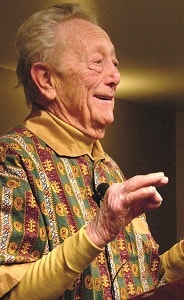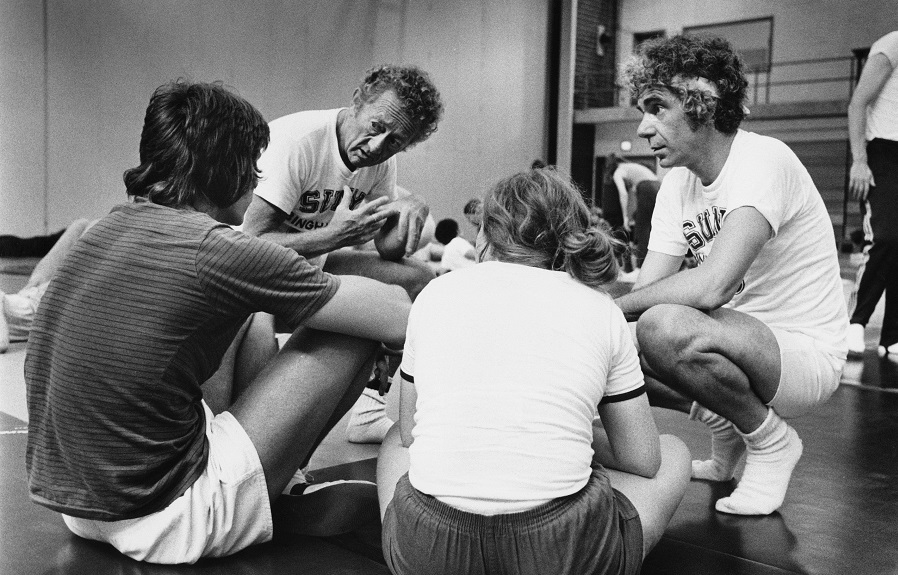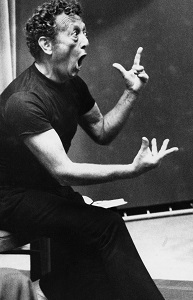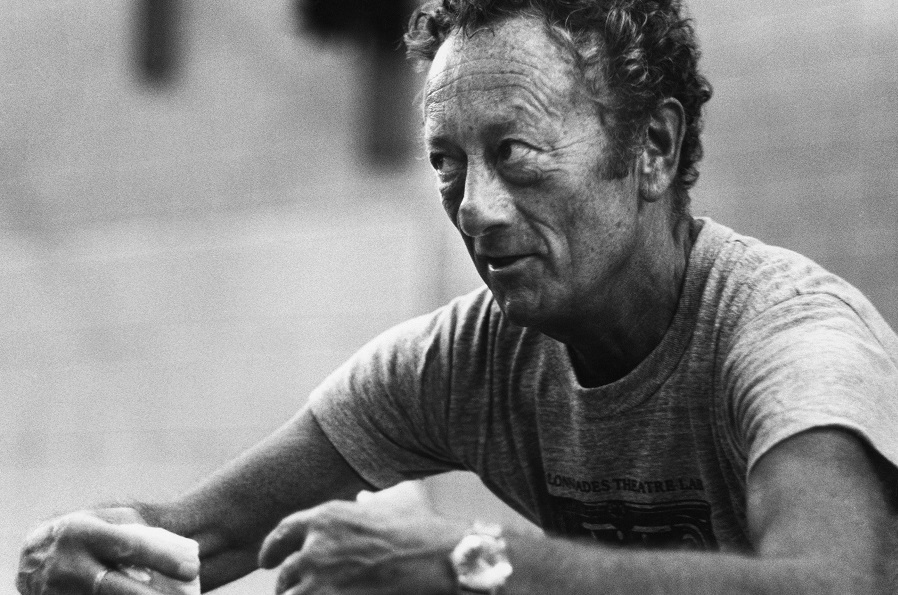Arthur Lessac, a living legend in voice work, created his voice, speech and body work out of his experiences as a speech therapist, voice and dialect coach, opera singer, actor, director and movement artist. In 1962, he was appointed by the directors Elia Kazan and Robert Whitehead as teacher of voice, speech, singing and dialects for their historic repertory company at Lincoln Center. Based on sensory learning and kinesthetic awareness, the Lessac Kinesensic Training is a bio-sensory approach that uses body and vocal energy states to reveal a largely untapped reservoir of knowledge, spirit and perceptive awareness. This essay is based on a speech Lessac gave in August ’09 at the Voice and Speech Trainers Association conference in New York City on the occasion of his 100th birthday.
Let us consider the words “original voice” not in terms of a specific way of training but in a much broader perspective—as something which is innate, in need of protection, and that should always be encouraged to grow and thrive. Such a voice could help create a better world which honors communing instead of just communicating.
Let me tell you a story; it’s a legend. In the very beginning, human communication was carried on entirely through the singing voice, with appropriate melodies, body rhythms and facial expressions. Whenever groups of people got together, the communication process would evolve into original choral exchanges. Their bodies would move into dance forms, and ensemble harmony was a natural occurrence. As the many years kept racing by, however, our sense of “time” became more frugal and more economical and, therefore, the amount of time it took for us to communicate became shorter and shorter—until what was left was barely enough time for consonants and vowels. Thus, speech was born, leaving precious little time for meaningful melodies, for harmony, for expressive sharing and certainly no time at all for supportive communing.
That’s where the legend ends. But if we were to continue the story, more and more consonants and vowels would no doubt be eaten up by time. In other words, our original voice would get fainter and fainter and could possibly get lost altogether.
How do I define “original voice”? (Not original thoughts, not original words, but original voices.) I decided to look up the word in several thesauruses. Did you know there are more than 60 synonyms for the word “original”? There’s “fundamental,” “new,” “unused,” “native” and “basic”—not to mention “cutting edge,” “new wave” and “new age”! I was overwhelmed. Finally, I came to “creative.” That’s it! I thought. Creative, fresh—yes. So I chose “creative” as part of my definition.

“Voice” also has many meanings. It can mean freedom of speech, taking a stand, our unique imprint on the world. I asked myself the question: What can a voice really do? Well, a voice can hum a lullaby and call you in to dinner, but it can also ring out in protest, sing out in pure joy, warn you of danger and cry out for freedom. Voice is so much more than tone or timbre, vowels or consonants—it is so much more than the apparatus itself. A voice that is free, that feels its inherent right to speak, will have no fear of calling out, whenever and wherever it is needed.
Most importantly, a voice can be a beacon in the darkness, something that lights the way for others.
Therefore, I chose “visionary” as the other part of my definition for “original voice”—someone who lights the way for others. An original voice is a creative visionary, someone with a remarkable energy. And I believe all of us who teach the methodologies of the voice are capable of being a beacon for others.
In fact, I believe that everyone, everywhere, is an original voice. Consider the newborn baby, fresh out of the womb. Talk about original! Every single baby born in this world is an original, like a Stradivarius violin, because no two babies are alike. Antonio Stradivari used only the finest woods to handcraft his violins, and each violin instrument, while essentially the same in appearance, produced an original, unique sound. Every baby is a Stradivarius violin, capable of producing unique music. As a matter of fact, a baby’s first cry is a perfectly placed clarion call—it’s exciting, pure, healthy, fresh, singing and strong.
Why is it, then, that many of us, as we grow into adulthood, suffer an adulteration of our “original voices”? What happens to that baby Strad? How does that original voice get lost or weakened or corrupted? I believe the answer lies in a better understanding of our environments. And I’m using the plural, environments, intentionally.
At this point, I ask you to seriously consider that we are all—all of us—living, functioning, creating and problem-solving in two separate, highly significant environments.
There is, on the one hand, the huge Outer Environment:
- with all its ecologies, histories and mysteries;
- with everything and everyone in it;
- with all its different energy uses and energy powers;
- with its conditioning and patterning;
- with its left-brained, quantitative forceful influence; and
- with its thousands and thousands of professionally
trained ecologists.
On the other hand, we have our very own, vastly infinite, personal Inner Environment:
- with its own ecology;
- with its own mysterious wilderness;
- with its own multitude of personal energy qualities;
- with its own right-brained qualitative and harmonic sensing;
- and, oh yes, with only one inner trained ecologist.
Every baby is born with this Inner Environment. Eventually the negative forces of the Outer Environment overpower a child. Pretty soon, the awareness of the Inner Environment has diminished so much that we lose touch with it—we lose our ability to feel it. But it still exists inside us—in this Inner Environment, a milieu or domain vaster than anything conceivable in the outside world, our original voices live and survive, though often unheard and unrecognized, even by us.
Too often, we become “cogs in the wheel” of the Outer Environment. Its patterns and its conditioning become our patterns and our conditioning, so much so that we don’t identify those patterns or conditions for the poisons they really are.
You may think I’m being extreme. After all, what do I mean by “poisons”? What are some of these poisons? The obvious ones include over-indulgence in food or alcohol, drug addiction and daily stress. Stress alone causes negative emotions to accumulate in the Inner Environment. Current research indicates significant connections between emotions and disease—anger contributes to heart disease, anxiety causes panic attacks or heart arrhythmia, depression contributes to headaches and back pain. Stress creates more than discomfort in the body—it creates ill-health. It slowly poisons.
Larger, societal poisons also afflict all of us. Frequently, for example, the Outer Environment asks us to accept “the lesser of two evils,” but my inner voice says a life surrounded by the lesser of two evils still means living under evil. We don’t want to live under the lesser of the two goods, either. Because our inner voices know that that particular “good” just may not be good enough. The Outer Environment seems perfectly content with half-truths, quarter-truths and perfect truths, whereas the Inner Environment tells us there is no such thing as a “half-truth” or a “quarter-truth” or a “perfect truth.” A “half-truth” or a “perfect truth” is a contradiction in terms. The Inner Environment tells us: Truth is truth; good is good…and poison is poison.
In our own Outer Environment today, right now, there is the poison of racism, the poison of thievery. Hunger is poison. Homelessness is poison. Being unjustly thrown out of a job is a nasty poison. Paying teachers with IOUs is a sneaky poison if there ever was one, and there is no end to this list. As far as I am concerned, the Outer Environment reflects a left-brained Democracy, with a large, capital “D,” which favors Big Interests and Corporate Monies. Our Inner Environment—with its heart, gut, soul and spirit energies—seems to favor an organic democracy with a small “d”—a democracy belonging to the people.
We can go for our entire lives without recognizing all the kinds of poisons that exist in our outer world. Take the economy, for example: Even with the recent downturn of the stock market, one could say that the average American lives in a fairly good economy. But do we really know what kind of economy we are living in? We’re not living in a capitalist economy. We’re not living in a socialist economy. We’re not living in a money or people’s economy. But we are, I regret to say, living in a military economy. All production is expected to feed and expand the worldwide military economy, and one of the most important products of that economy is war. Our planet has been poisoned with continuous war for an awfully, awfully long time. Mind you, war develops its own poisons such as killing, murdering, torturing, hating and so forth. Hence, war is the greatest poison of all.
As you might guess, I strongly prefer that the Inner Environment influence the Outer Environment rather than vice versa. Why? Because the Outer Environment stifles and starves the Original Voice, and we’ve been losing our voices at a relentless rate. Moreover, I believe that by developing our awareness of the feeling sense within us we can become better ecologists for ourselves.
What is the feeling sense? We all experience the Outer Environment through the five outer senses (touch, hearing, taste, smell and sight)—which are quantitative (meaning they can be measured) and therefore can be limited.
But, in our Inner Environment, we do our experiencing and sensing through one sense only—the feeling sense, and I call its workings “the feeling process.” It is very close to our common use of the sixth sense it also takes us a step closer to that elusive “soul” energy. Yes, for me, “soul” is the most delicate of all our inner body energies.

What do I mean when I talk about energy? In very general terms, I am speaking of kinetic energy, the energy of motion. All matter in the universe is in motion; therefore, everything in the universe is energy—including us. In our Inner Environment, we have definable energy qualities that can be felt neuro-physically. From my own research, I discovered that:
- There is an inner energy quality that makes our bodies feel lighter, weightless, floating; I call this inner-felt sensing “buoyancy” energy.
- There is an inner energy that gives us a newfound strength, power and resilience, which I call “potency” energy.
- There is an energy that helps us experience the various sensations of cheer/glee/exhilaration, which I call inner-felt “radiancy” energy.
- And there is an inner energy that helps us feel our vocal and verbal sensations and we call that “tonal” energy. It incorporates the music of tone, the music of consonants, the music of vowels and the music of speech. Understanding tonal energy leads us to a livelier appreciation of the poetic expression “Music is the universal language of mankind.” For me, “Voice is the speech of angels.”
We can also learn to feel the energy of courage, of awareness, of curiosity, or the energies of spirit and of love. And when I feel them, I sense a bit of questing within myself or, better still, a bit of mystery. When the British essayist and historian Thomas Carlyle wrote that “the perception of the mysterious is the origin of discovery,” I interpret his statement to mean the discovery of fascinating qualities and sensations within our Inner Environments.
I am not alone in this recognition of the inner feeling process and its importance. The poet William Butler Yeats said: “God spare me from men who think in their heads alone; he who sings a lasting song sings in the marrow bone.” Here is a person who recognizes the power of the energy found in the Inner Environment.
The German philosopher Nietzsche said: “There is more wisdom in your body than in your deepest philosophy.” You see, he recognizes that it is our feeling process that holds the key to learning, not our thinking.
And Henry Wadsworth Longfellow wrote: “How wonderful is the human voice! It is indeed the organ of the soul. The intellect of man is enthroned visibly on his forehead and in his eye, and the heart of man is written on his countenance, but the soul, the soul reveals itself in the voice only.” (Bless his soul.)
And then there’s the story of Arthur Rubinstein, the great virtuoso pianist. He had thoroughly prepared himself for a very, very special performance, but when he was on the stage performing, he found that part of his creative playing at this concert was outside his carefully practiced repertoire. Later, he said, “If my fingers hadn’t done it, my mind would never have thought of it.”
This is all Inner Environment awareness…and what I hear Rubinstein saying is that this experience happened through a feeling process—not through an intellectual process. His preparation probably included both. But in that moment in performance, it was his feeling process that taught him more about his artistry than all his practicing had done.
These artists and philosophers—themselves creative visionaries—perceived the mysterious feeling process within themselves and in others and held it up as a beacon to creativity, originality, leadership and wisdom. This is Original Voice. It is only found in the Inner Environment. And when the poisons of the Outer Environment invade the Inner Environment the original voice withers and even disappears.
But here’s the encouraging part: Our feeling process recognizes these poisons.

Our inner body energies give us the informational experiences that open the door to health and wellness and humanness and communing. And the really good thing about this is that no poison can possibly coexist or cohabit with any of our Inner Environment energy qualities. One or the other must leave. They cannot live together. If, when we walk, we feel the rhythm of dancing and if, when we talk, we feel the lilt of singing, our Inner Environment fills up with joy, pleasure, laughter and spirit-fullness. In such an environment, it is impossible to also harbor hate, fear, jealousy or rage.
And if, within these parameters, we recognize a poison, the wisest thing to do is to kick the damn thing out! Our world is contaminated by pains, rash and fever—we call them poverty, hunger and pollution, among other things—and to stay healthy as theatre artists, it is therefore in our best interest to combat all poisons in the Outer Environment. (In fact, we must become selfish—very selfish—about health, for individual wellness is at stake here.) If we recognize, too, that jealousy, hate or fear are poisons far worse than the fevers or rashes or pains experienced by our human bodies, then we would immediately use our natural energy resources to get rid of them and, yes, regain our health, regain our posture, regain our voice.
Arthur Lessac is among the most highly regarded teachers of voice, speech, singing and movement in the training world. He has taught three generations of actors, singers and dancers, among whom are Martin Sheen, Beatrice Straight, George Grizzard, Faye Dunaway, Michael Douglas, Frank Langella, Michael O’Keefe, Peter Scolari and Linda Hunt. His two books, “The Use and Training of the Human Voice: A Bio Dynamic Approach to Vocal Life” and “Body Wisdom: The Use and Training of the Human Body,” are considered a lasting contribution to the field of acting and performing.


